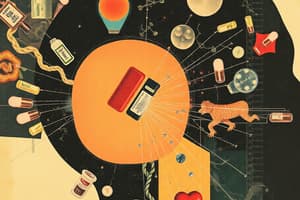Podcast
Questions and Answers
What is the primary function of scopolamine?
What is the primary function of scopolamine?
- Pain relief
- Sedation and twilight anesthesia (correct)
- Increasing heart rate
- Enhancing memory retention
LSD was synthesized in 1938 and later became illegal in 1968.
LSD was synthesized in 1938 and later became illegal in 1968.
True (A)
Which compound is chemically similar to serotonin and is found in mushrooms?
Which compound is chemically similar to serotonin and is found in mushrooms?
Psilocybin or psilocin
Bufotenine is found in the skin of toads of the genus ______.
Bufotenine is found in the skin of toads of the genus ______.
Match the following psychedelics with their primary characteristics:
Match the following psychedelics with their primary characteristics:
What effect is commonly associated with the low doses of anticholinergic psychedelics?
What effect is commonly associated with the low doses of anticholinergic psychedelics?
Ololiuqui is the same as LSD.
Ololiuqui is the same as LSD.
What was MDMA originally developed for in 1914?
What was MDMA originally developed for in 1914?
The primary receptors that serotonergic psychedelics bind to are ______ receptors.
The primary receptors that serotonergic psychedelics bind to are ______ receptors.
Which of the following is not a serotonergic psychedelic?
Which of the following is not a serotonergic psychedelic?
Flashcards
Psychedelic effects of Scopolamine
Psychedelic effects of Scopolamine
Low doses of scopolamine cause sedation, mild euphoria, and amnesia. High doses lead to euphoria, hallucinations, and excitement. Peripheral effects include tachycardia, increased body temperature, and dry mouth.
LSD's mechanism of action
LSD's mechanism of action
LSD binds to 5-HT2A receptors in the prefrontal and cingulate cortex, causing perceptual distortions (visual, auditory, and space/time).
Serotonergic Psychedelics
Serotonergic Psychedelics
These psychedelics, chemically similar to serotonin, include LSD, ololiuqui, bufotenine, psilocybin, and psilocin.
Ololiuqui
Ololiuqui
Signup and view all the flashcards
Bufotenine
Bufotenine
Signup and view all the flashcards
Psilocybin / Psilocin
Psilocybin / Psilocin
Signup and view all the flashcards
Mescaline
Mescaline
Signup and view all the flashcards
MDMA (Ecstasy)
MDMA (Ecstasy)
Signup and view all the flashcards
Entactogens
Entactogens
Signup and view all the flashcards
Historical LSD use
Historical LSD use
Signup and view all the flashcards
Study Notes
Psychedelic Drugs: Types and Effects
-
Anticholinergic: Scopolamine is an anticholinergic. Low doses cause sedation, mild euphoria, and amnesia, while high doses induce euphoria, hallucinations, and excitement. Peripheral effects include increased heart rate (tachycardia), higher body temperature, and dry mouth. Used as a form of twilight anesthesia.
-
Serotonergic: These drugs are chemically similar to serotonin.
- LSD (Lysergic Acid Diethylamide): A synthetic derivative of ergot, developed in the 1930s. Binds to 5-HT2A receptors in the brain, leading to perceptual distortions (visual, auditory, space/time). Synthesized in 1938, used therapeutically/experimentally from the 1950s to 1970s, including military contexts. Illegal possession in the U.S. since 1968.
- Ololiuqui: The seeds of morning glories contain a psychedelic compound, lysergic acid amide, which is NOT LSD.
- Bufotenine: An alternative metabolite of serotonin, may be found in individuals with psychiatric disorders and in toads of the Bufo genus.
- Psilocybin & Psilocin: Found in "magic mushrooms" (psilocybin mushrooms). Renewed interest in psilocybin as a treatment for depression, PTSD, addiction, and end-of-life anxiety.
-
Catecholamine-like: These drugs are chemically similar to norepinephrine and dopamine. Methoxylated structures confer psychedelic properties due to interactions with the 5-HT2A receptor.
- Mescaline: Causes anxiety, visual distortion, and tremors.
- Synthetic Methoxylated Amphetamine Derivatives: Including DOM, MDA, DMA, MDE, TMA, AMT, and MDMA. These drugs increase the release and/or inhibit the reuptake of monoamines and acetylcholine.
- MDMA: Developed in 1914 for appetite suppression. Tested in the U.S. military in the 1950s, and experienced renewed interest in psychological treatment during the 1970s and popularity with college students. Reported effects include empathy, insight, enhanced communication, and transcendent religious experiences. Can cause sympathomimetic effects, anxiety, and potentially malignant hyperthermia or neurotoxicity.
-
Antiglutamatergic: These drugs act as antagonists of the NMDA receptor.
- Phencyclidine (PCP) & Ketamine: Cause confusion, altered perception, stupor, and coma. Originally developed as safer anesthetic and analgesic agents.
-
Kappa Opioid Agonist:
- Salvinorin A: Causes hallucinations and dysphoria.
Studying That Suits You
Use AI to generate personalized quizzes and flashcards to suit your learning preferences.
Description
Explore the various types of psychedelic drugs, including anticholinergic and serotonergic categories. This quiz covers their effects, historical context, and notable substances like LSD and ololiuqui. Test your knowledge on the pharmacological properties and applications of these intriguing compounds.




